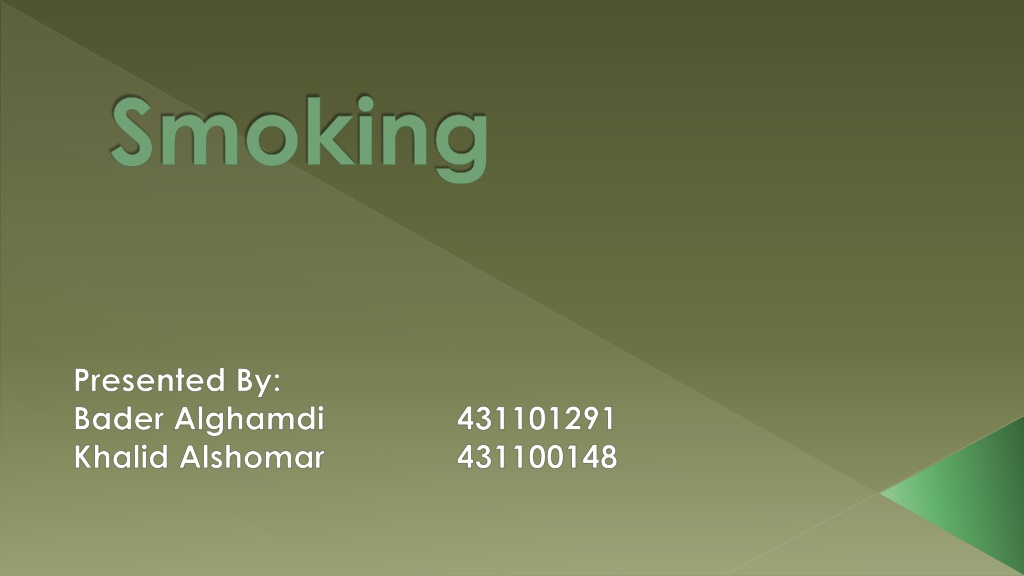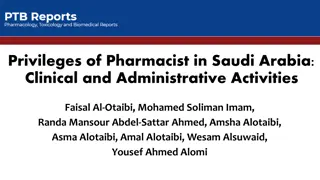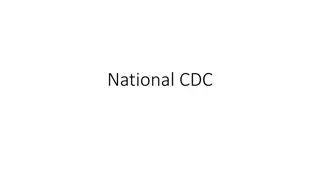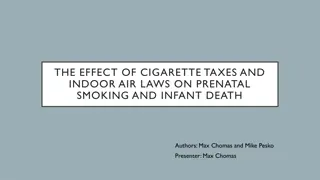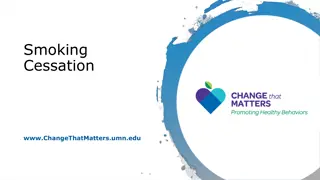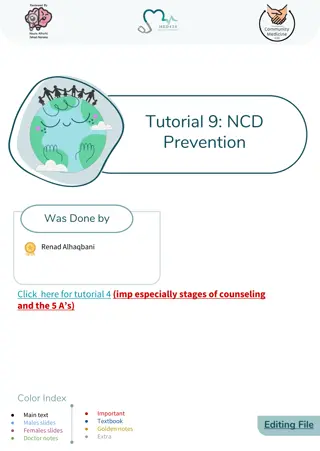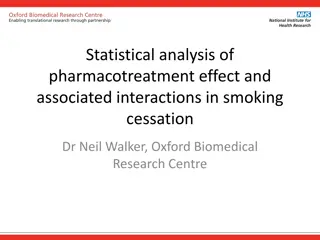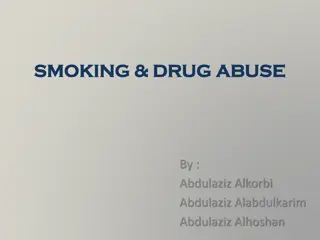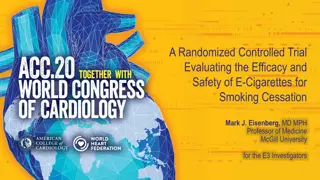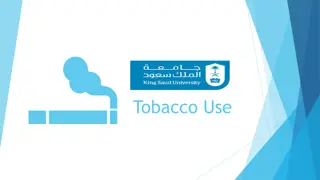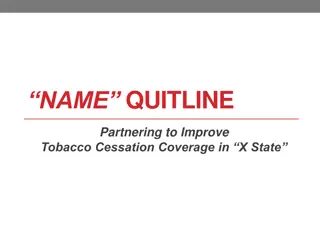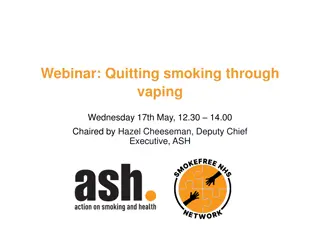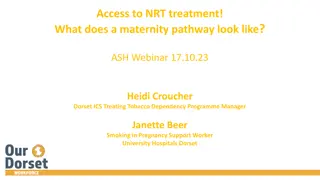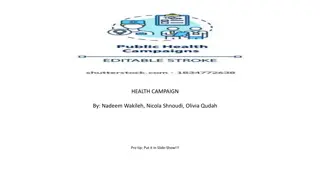Smoking: Risks, Cessation, and Public Health Concerns in Saudi Arabia
This presentation on smoking in Saudi Arabia covers the epidemiology, risks, and effects of smoking, including passive smoking. It also discusses strategies for smoking cessation, the role of healthcare professionals, and updates on pharmacological management. A case scenario of a smoker seeking help is presented, along with multiple-choice questions on smoking-related topics.
Download Presentation

Please find below an Image/Link to download the presentation.
The content on the website is provided AS IS for your information and personal use only. It may not be sold, licensed, or shared on other websites without obtaining consent from the author. Download presentation by click this link. If you encounter any issues during the download, it is possible that the publisher has removed the file from their server.
E N D
Presentation Transcript
Smoking Presented By: Bader Alghamdi Khalid Alshomar 431101291 431100148
Objectives Epidemiology of smoking in Saudi Arabia. Risks of smoking (Morbidity and Mortality). Effect of passive smoking on pregnancy, children How are you going to help the smoker to quit and how to overcome withdrawal symptoms. Role of PHC physician smoking cessation clinic . Update in pharmacological management, smoking cessation medication. Nicotine preparations, varniciline, bupropion
Case scenario Ahmad is 33 year old man who has been smoking for 15 years came to the PCC after his attempts to quit smoking failed, he told you that he tried several times in the past 5 years to quit but he couldn t. His wife advised him to seek medical help so he came to you. How can you help Ahmad?
MCQs Which one of the following causes more deaths ? A. Human immunodeficiency virus (HIV) B. Smoking C. Alcohol use D. Motor vehicle injuries
MCQs o Smoking can damages blood vessels and can make them: A. Thick, narrower and increases blood pressure B. Thin, wider and increases blood pressure C. Thick, narrower and decreases blood pressure D. Thin, wider and decreases blood pressure
MCQs What is passive smoking? A. Smoking shisha B. Smoking everyday C. breathing in other people s tobacco smoke D. chewing tobacco
MCQs What is the prevalence of daily tobacco smoking among adult males in KSA in 2012? A. 15 % B. 24 % C. 35 % D. 41 %
MCQs What is the mechanism of action for Varenicline ? A. causes cigarettes to have a bad taste B. reduce the anxiety associated with nicotine withdrawal C. inhibits the uptake of norepinephrine, serotonin, and dopamine which leads to reduction in the urge of smoking. D. blocks nicotine-receptor sites yet partially stimulates the receptors, resulting in moderate levels of dopamine in the terminal synapse
Epidemiology of Smoking in KSA WHO age-standardized estimated prevalence of smoking among those aged 15 years or more: Year 2011 Adult prevalence, smoking (%) Current* Any smoked tobacco Cigarettes Daily Current* Daily Male 38 31 32 24 Female <1 <1 <1 <1 Total 22 17 18 14 *Current smokers are defined as persons who reported smoking at least 100 cigarettes during their lifetime
Prevalence Prevalence of smoking among secondary school male students in Jeddah, Saudi Arabia: a survey study Among students of age 16 22 years. A total of 695 students responded to the questionnaires with an 87.4% response rate. Two hundred fifty-eight (37%) of the study group were current smokers. The most common reasons given for smoking were: personal choice (50.8%) the peer pressure from smoker friends (32.8%). Many students researched the smoking hazards (68.1%), but only 47.6% knew about the bad effects of passive smoking. Two thirds of the smoking students wanted to quit smoking (63.2%), especially if suitable help was available, and 75.1% tried to quit. A third of the smoking students (36.8%) found it difficult to stop smoking in no-smoking areas. http://www.biomedcentral.com/1471-2458/13/1010
Risks of smoking (Morbidity and Mortality) Cigarette smoking causes more than 480,000 deaths each year in the United States. This is about one in five deaths. Smoking causes more deaths each year than all of these combined: Human immunodeficiency virus (HIV) Illegal drug use Alcohol use Motor vehicle injuries Firearm-related incidents
Risks of smoking (Morbidity and Mortality) Smokers are more likely than nonsmokers to develop heart disease, stroke, and lung cancer. Smoking is estimated to increase the risk Coronary heart disease by 2 to 4 times Stroke by 2 to 4 times Lung cancer by 25 times
Smoking and Cardiovascular System Smoking causes stroke and coronary heart disease the leading causes of death in the United States. Smoking damages blood vessels and can make them thicken and grow narrower. This makes your heart beat faster and your blood pressure go up. Clots can also form. Even people who smoke fewer than five cigarettes a day can have early signs of cardiovascular disease.
Smoking and Respiratory System Lung diseases caused by smoking include COPD, which includes emphysema and chronic bronchitis. Smoking can cause lung disease by damaging the airways and the alveoli. Cigarette smoking causes most cases of lung cancer. In presence of asthma, tobacco smoke can trigger an attack or make an attack worse. Smokers are 12 to 13 times more likely to die from COPD than nonsmokers
Smoking and Cancer Smoking can cause cancer almost anywhere in your body: Trachea, bronchus, and lung Bladder Esophagus Larynx Oropharynx (includes parts of the throat, tongue, soft palate, and the tonsils) If nobody smoked, one of every three cancer deaths in the United States would not happen.
Types of Smoking Conventional smoking Passive ( second hand) smoking
Effect of passive smoking What is passive smoking? Passive smoking means breathing in other people s tobacco smoke. Exhaled smoke is called exhaled mainstream smoke. The smoke drifting from a lit cigarette is called sidestream smoke. The combination of mainstream and sidestream smoke is called second- hand smoke (SHS).
Effect of passive smoking on pregnancy and children
Effect of passive smoking on pregnancy and children Kids are particularly at risk for the effects of secondhand smoke because their bodies are still growing and they breathe at a faster rate than adults. Conditions have been linked to secondhand smoke exposure in children: Sudden infant death syndrome (SIDS) More respiratory infections (such as bronchitis and pneumonia) More severe and frequent asthma attacks Ear infections Chronic cough
Effect of passive smoking on pregnancy and children Smoking during pregnancy is especially dangerous to the developing baby. It's tied to premature delivery, low birth weight, SIDS, limited mental ability, trouble with learning, and ADHD. The more cigarettes a mother-to-be smokes, the greater the danger to her baby. 5 % of infant deaths, 10 % of preterm births
How are you going to help the smoker to quit and how to overcome withdrawal symptoms?
Why is it so hard to quit smoking? Nicotine Found naturally in tobacco, which is as addictive as heroin or cocaine. Over time, a person becomes physically dependent on and emotionally addicted to nicotine. This physical dependence causes unpleasant withdrawal symptoms when you try to quit. The emotional and mental dependence (addiction) make it hard to stay away from nicotine after you quit. Studies have shown that to quit and stay quit, smokers must deal with both the physical and mental dependence
Why quit smoking now? No matter how old or how long a person s smoked, quitting can help live longer and be healthier. People who stop smoking before age 50 cut their risk of dying in the next 15 years in half compared with those who keep smoking. Ex-smokers enjoy a higher quality of life they have fewer illnesses like colds and the flu, lower rates of bronchitis and pneumonia, and feel healthier than people who still smoke.
Why quit smoking now? Immediate rewards of quitting smoking: Breath smells better Stained teeth get whiter Bad smell in clothes and hair go away Yellow fingers and fingernails disappear Food tastes better Sense of smell returns to normal Everyday activities (such as climbing stairs or light housework) no longer leave them out of breath They can be in smoke-free buildings without having to go outside to smoke. Cost Social acceptance
Getting help with the mental and physical addiction Some people are able to quit on their own, without the help of others or the use of medicines. But for many smokers, it can be hard to break the social and emotional ties to smoking while getting over nicotine withdrawal symptoms at the same time. Fortunately, there are many sources of support out there: Quit-smoking programs: Tobacco Control Program; Ministry of Health(http://www.sa- tcp.com) Purity Organization; Ministry of Social Affairs(http://naqa.org.sa/) Support of family and friends And for the physical part of addiction nicotine replacement therapy (NRT) is used
Withdrawal symptoms can include any of the following: Dizziness (which may last 1 to 2 days after quitting) Depression Feelings of frustration, impatience, and anger Anxiety Irritability Sleep disturbances Trouble concentrating Restlessness or boredom Headaches Tiredness Increased appetite Weight gain Constipation and gas Cough, dry mouth, sore throat, and nasal drip Chest tightness Slower heart rate
Dealing with smoking withdrawal If someone s been smoking for any length of time, smoking has become linked with a lot of the things in daily life waking up in the morning, eating, reading, watching TV, and drinking coffee, for example. It will take time to un-link smoking from these activities. This is why, even if nicotine replacement therapy is used, strong urges to smoke will may present.
Tips to overcome withdrawal symptoms Avoid temptation. Stay away from people and places that tempt you to smoke. Later on you ll be able to handle these with more confidence. Change your habits. Switch to juices or water instead of alcohol or coffee. Choose foods that don t make you want to smoke. Take a different route to work. Take a brisk walk instead of a smoke break. Choose other things for your mouth: Use substitutes you can put in your mouth such as sugarless gum or hard candy, raw vegetables such as carrot sticks, or sunflower seeds. Some people chew on a coffee stirrer or a straw. Get active with your hands: Do something to reduce your stress. Exercise or do something that keeps your hands busy, such as needlework or woodworking, which can help distract you from the urge to smoke. Take a hot bath, go for a walk, or read a book.
Tips to overcome withdrawal symptoms Breathe deeply: When you were smoking, you breathed deeply as you inhaled the smoke. When the urge strikes now, breathe deeply and picture your lungs filling with fresh, clean air. Remind yourself of your reasons for quitting and the benefits you ll gain as an ex-smoker. Delay: If you feel that you re about to light up, hold off. Tell yourself you must wait at least 10 minutes. Often this simple trick will allow you to move beyond the strong urge to smoke. Reward yourself. What you re doing isn t easy, and you deserve a reward. Put the money you would have spent on tobacco in a jar every day and then buy yourself a weekly treat. Buy a book or some new music, go out to eat, start a new hobby, or join a gym. Or save the money for a major purchase.
Role of primary health care physician in smoking cessation
If patient is not ready to quit The model of 5 Rs Relevance Motivational information has the greatest impact if it is personally relevant to the patient s circumstances, such as their disease status or risk, prior quitting experience, and personal barriers to cessation. Risks Ask the patient to identify potential negative consequences associated with tobacco use. Stress the risks most applicable to the patient, including: Acute health risks shortness of breath, harm to pregnancy Long-term risks heart attacks and stroke, lung, and other cancers Environmental risks Increased risk of lung cancer in partners, respiratory infections in children of smokers
If patient is not ready to quit The model of 5 Rs Rewards Encourage the patient to identify potential benefits of quitting smoking and highlight those most relevant to the patient, such as improved health in themselves and their family members, saving money, improved performance in sports, etc. Roadblocks Invite the patient to identify barriers or impediments to quitting and suggest treatments (problem solving counseling, medication) that could address such barriers. Repetition Repeat the motivational intervention every time an unmotivated patient visits the clinic setting. Tobacco users who have failed in previous quit attempts should be reminded that the majority of people make repeated quit attempts before they achieve success.
Pharmacological management in smoking cessation: Silver acetate causes cigarettes to have a bad taste the literature showed that it is not effective. Alprazolam (Xanax) and other benzodiazepines reduce the anxiety associated with nicotine withdrawal. Mecamylamine (Inversine ) together with transdermal nicotine replacement has been shown to improve the abstinence rate in smokers, compared with use of the patch alone
Electronic Cigarette An electronic cigarette (e-cig or e-cigarette), or electronic nicotine delivery system (ENDS) is a battery-powered vaporizer which has a similar feel to tobacco smoking. Electronic cigarettes do not contain tobacco, although they do use nicotine from tobacco plants. They do not produce cigarette smoke but rather an aerosol, which is frequently but inaccurately referred to as vapor.
E-cig in Smoking Cessation As of 2014, research on the safety and efficacy of e-cigarette use for smoking cessation is limited. Their benefit in helping people quit smoking is uncertain. A 2014 Cochrane review found that e-cigarettes can help people quit, but was based on a small number of studies. Two 2014 reviews found no evidence that e-cigarettes are more effective than existing nicotine replacement treatments for smoking cessation
Nicotine replacement therapy (NRT) Nicotine Patch Nicotine Gum Nicotine Inhaler Nicotine Nasal Spray
Comparison of Delivery Systems: Patient preference usually determines the choice of nicotine replacement modality. For example, the patient who needs to be doing something with his or her hands may prefer the nicotine inhaler over the nicotine patch. The patient who is concerned about gaining weight may prefer to use nicotine gum, which has been shown to delay (but not prevent) weight gain associated with smoking cessation
Bupropion Bupropion inhibits the uptake of norepinephrine, serotonin, and dopamine reduce the urge of smoking. The quit date should be set for one to two weeks after bupropion therapy is initiated. Bupropion therapy is usually continued for eight to 12 weeks after the patient has quit smoking. Contraindications: A history of seizure disorder The presence of eating disorders. Uncontrolled hypertension
Varenicline Varenicline blocks nicotine-receptor sites yet partially stimulates the receptors, resulting in moderate levels of dopamine in the terminal synapse. It increases the chances of a successful quit attempt two- to threefold compare with no pharmacologic assistance. Varenicline is superior to bupropion in promoting abstinence. There is increased risk of coronary events with varenicline
MCQs Which one of the following causes more deaths ? A. Human immunodeficiency virus (HIV) B. Smoking C. Alcohol use D. Motor vehicle injuries
MCQs Smoking can damages blood vessels and can make them: A. Thick, narrower and increases blood pressure B. Thin, wider and increases blood pressure C. Thick, narrower and decreases blood pressure D. Thin, wider and decreases blood pressure
MCQs What is passive smoking? A. Smoking shisha B. Smoking everyday C. breathing in other people s tobacco smoke D. chewing tobacco
MCQs What is the prevalence of daily tobacco smoking among adult males in KSA in 2012? A. 15 % B. 24 % C. 35 % D. 41 %
